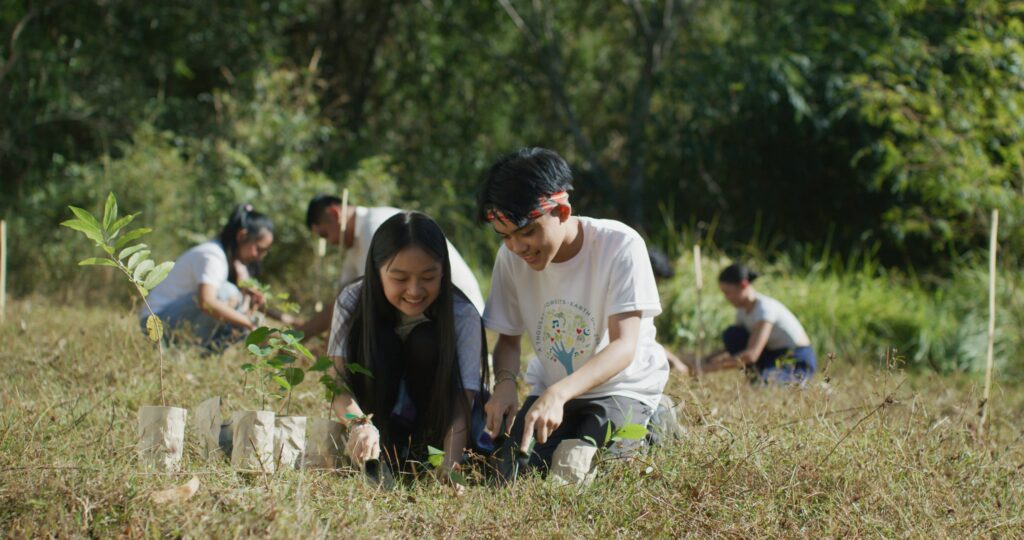
FREQUENTLY ASKED QUESTIONS
What is “A Thousand Forests” Program?
It’s an environmental program primarily aimed at educating the youth and the public on the role of forests in climate change adaptation and mitigation through multi-stakeholder partnerships to establish thousands of new forests in public/ timberlands/ forest lands, and private lands.
Who and how can we participate?
First, you can help create awareness by watching and sharing the A Thousand Forests film. You may sponsor a film viewing for school children from public elementary schools, or a blocked screening for your organization.
For the tree planting implementation, start by piloting a tree planting site in any region of the country. The target in 2024 is to have one site per region.
The ATF program aims to encourage private sector and civil society engagement in tree planting and nurturing activities, in partnership with the communities with forest tenurial instruments.
Specifically, schools, licensed professionals, private companies, government agencies, and individuals may participate in the program.
How soon will the planting be implemented?
ATF will initially be piloted in all regions of the country. Tree planting can commence during the onset of the rainy season this year within CBFM areas
Who will monitor? How will the planted trees be monitored?
The Philippine Forestry Education Network (PFEN), a network of some 38 State Universities and Colleges (SUCS) and private schools offering a BS Forestry program shall be undertaking the monitoring and evaluation of the trees planted by the different sectors, particularly the participating primary and secondary schools.
This will be done as part of the forestry curriculum through hands-on activities, extension work and capacity-building programs.
Who are the major stakeholders and what are their responsibilities?
Tree Planters
- Elementary and High Schools, both public and private
- PRC Licensed Professionals (carbon neutral professionals) who would want to offset their carbon footprint
- Private companies or organizations who would want to offset their carbon footprint
- Government agencies who would want to offset their carbon footprint
- Individuals who would want to offset their carbon footprint
Monitoring, Verification, Reporting
- A Memorandum of Agreement will be signed between PFEN and DepEd/DENR/SUCs-CHEd-/ATF Program Implementer.
- PFEN and the SUCs will be expected to check the area planted in terms of extent, baseline, species planted, seedlings planted, survival rates, carbon content in trees within 3-6 years
- Reporting and uploading in a centralized database. If the participating schools are only concerned with tree planting and no monitoring and evaluation will be accomplished, they will not be included in the program.
UPLB – College of Forestry and Natural Resources
- Establishment of new forests or plantations in the land grant areas
- Manage the centralized database. The intention is to report to the public the achievements thus far concerning the targets, challenges encountered, and how to be more effective and efficient in achieving the greening efforts.
- Provide capacity building to PFEN schools in partnership with PFEN
- Continuous research and development on measuring the carbon content of trees
- CFNR through the Institute of Agroforestry can provide livelihood training for the POs. They may also teach the elementary students about planting vegetables and other crops aside from trees to ensure harvesting
- The Training Center for Tropical Resources and Ecosystems Sustainability (TREES) may provide an online course, module, or video (maximum of 10 minutes) to demonstrate tree planting to elementary students
ENR (FMB, CENROs)
- Identification of community-based forest management sites
- Providing seedlings endemic to the sites
- Establishment of new forests or plantations in partnership with the other stakeholders
- Technical assistance to participating SUCs
- MRV
LGUs (Barangays, Municipalities)
- Help in the establishment of new forests or plantations by coordinating with the SUCs in the tree planting activities and M&E
- Distribute seedlings and maintain their growth before tree planting
- Construction of roads, trails, and other pathways leading to the tree-planting sites
- Technical assistance
Non-government Organizations
- Establishment of new forests or plantations by identifying new sites and participating in tree planting activities and M&E
- Distribute seedlings and maintain their growth before tree planting
- Provide funding for the ATF program
- Technical assistance
Private Companies
- Establishment of new forests or plantations by identifying new sites and participating in tree planting activities and monitoring and evaluation
- Distribute seedlings and maintain their growth before tree planting
- Provide funding for the ATF program
- Technical assistance
How does this differ from the government’s NGP?
The ATF Program will complement the government’s National Greening Program (NGP). While NGP is primarily a government-funded program, ATF will primarily be private-sector-led. The ATF Program also aims to synergize and complement the government’s programs such as the NGP and CBFM.
How much does it cost to fund the planting of a tree or a hectare of forest?
The cost to plant and maintain a seedling for the next five years is estimated at Php 275. On the other hand, planting and maintaining a hectare for the same period will cost around Php150,000 per hectare.
This includes the cost of the seedlings, hauling, site preparation, hole digging, planting, weeding, fertilization, protection, and growth measurements. Different species shall be planted, generally classified into forest species for protection purposes, comprising of indigenous and native species not intended for harvesting; forest species, also native and indigenous, intended for utilization to help meet the country’s domestic wood requirements; and, fruit-bearing trees for livelihood purposes. Most of the funds will go to the community members who will undertake the plantation activities.
Where would the tree planting be done?
Tree planting activities will be done only in tenured areas, giving preference to Community-Based Forest Managed (CBFM) areas. Tenured areas are public lands where qualified upland communities, organizations, or individuals are given access rights and control to manage public lands.
The CBFM members, who will undertake the planting of trees are poor upland farmers who mostly depend on the forest resources for their livelihood. If left without support, they practice slash-and-burn farming which causes deforestation and forest degradation which significantly contributes to global warming.
Why should the tree planting be done with Community-Based Forest-Managed sites?
Since CBFM sites are tenured areas, the members will be accountable stewards or managers of the trees planted. Planting within CBFM sites will provide livelihood opportunities to them in the form of wages, crops, and trees, which can be harvested in the short, medium, and long-term periods, thus discouraging them from engaging in slash-and-burn farming.
Planting should also prioritize degraded and deforested uplands since these areas contribute to geohazards (e.g. flooding, soil erosion, landslides, scarce water) in the lowlands. However, there should be an accountable steward of the seedlings planted until these attain maturity.
Once the established forests become productive, the areas will not only provide immediate livelihood to the upland communities but have multiple benefits to the lowland communities as well
Planting sites will be in the nearest CBFM area or tenured public lands with a manager/steward of good standing
What are Carbon Credits and how are they computed?
Carbon credits are a kind of tradeable permit or certificate that represents the right to emit one ton of carbon dioxide (CO2) or an equivalent amount of another greenhouse gas. They are typically used within cap-and-trade schemes as a way to limit greenhouse gas emissions. Essentially, entities that produce fewer emissions than their allowance can sell their excess credits to those who exceed their quota, thus creating a financial incentive for reducing emissions. Carbon credits play a role in mitigating climate change by encouraging companies and governments to invest in cleaner technologies and practices
To compute carbon credits, a baseline level of carbon emissions without any intervention should be determined. This will serve as the reference point for measuring emissions reductions in the future. Typical projects such as afforestation, reforestation, and restoration (ARR) activities are aimed at reducing emissions or increasing carbon sequestration.
The carbon storage and sequestration rate of planted trees from these initiatives are monitored and measured regularly (i.e. every year) to estimate the carbon content and carbon dioxide equivalent (CO2-e). These are then compared to baseline values to determine the actual emissions reductions.
Usually, an independent third-party verifier is engaged to validate the calculation of the emissions reductions and to verify whether they meet the requirements of a specific carbon standard or methodology such as the Verified Carbon Standard (VCS). Once the emissions reductions have been validated and verified, a certificate for the carbon credits equivalent to the emissions reductions will be issued.
In the case of the Philippines, interested parties can enroll their ARR projects in the Carbon Accounting, Verification, and Certification System (CAVCS) for forest carbon projects of the Department of Environment and Natural Resources (DENR), and obtain certification for its initiatives.
It must be noted that various factors such as geographic location, species composition, regulatory requirements, and others can influence the calculation of carbon credits. Further, continuous monitoring and reporting is an essential part of the process to ensure ongoing emissions reductions and maintain the validity of the carbon credits.
How do you measure carbon stored in the biomass of trees?
There are two ways to determine carbon storage in trees:
Destructive Method
- Harvesting and sampling of trees depending on species, age, size, elevation, soil, among other parameters
- Estimation of forest biomass from fresh weight by weighing the sample of tree parts such as stem, branches, foliage, and roots and oven-dry weight after subjecting the samples to oven-drying.
- Carbon content determination wherein the sample parts of the tree are dried and ground into a fine powder to measure the amount of carbon relative to the other elements in the sample.
Non-destructive Method
- Measurement of tree parameters such as diameter and height.
- Estimation of tree or forest biomass using published allometric equations for different species and forest types.
- Determination of carbon content from forest biomass following the general rule that about 45-50% of biomass is equal to carbon content.
For both methodologies, the determination of the carbon dioxide equivalent (CO2-e) is done by multiplying the carbon content with the molecular weight of carbon dioxide.
* On average, a tree absorbs about 10 kilograms of carbon dioxide per year for the first 2 years of its life (https://onetreeplanted.org)

